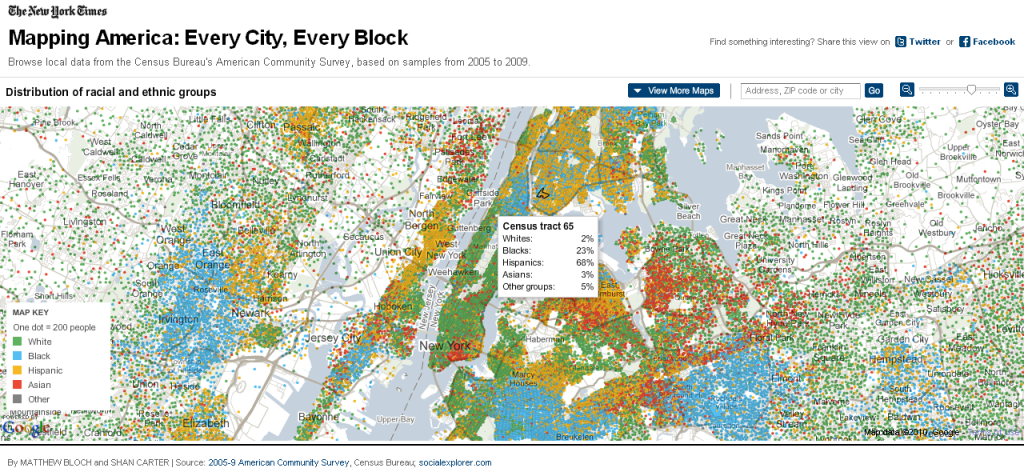The Malofiej 20 awards, known as the Pulitzers of the infographics world, recognize the finest infographics published across the globe. This year, more than 1,500 print and online submissions competed for the prestigious awards. National Geographic Magazine, which won best print map and two gold awards, and Internet Group do Brasil iG (gold) were notable achievements. However, as in previous years, the portfolio of graphics from the New York Times dominated the event, winning six gold medals (four print, two online), the best online map and both the ‘Best in Show’ awards for print and online submissions. So what are the secrets to the New York Times’ continued success? Here are 10 key characteristics that, when brought together in a synthesised design process, helps to separate their work from the rest.
1. Clarity of context and purpose
Establishing the goal of a visualization or infographic is the first consideration in its development, before any creative process has commenced. Is it to enable interaction and personal discovery of data? Is it to convey a story or enhance a specific editorial perspective? Will it be a static, an interactive or even a video? All these key design decisions will be based on the clarity of concept at this initial stage of the process and this is one area in which the New York Times excels. 
2. Respect for the reader
The overriding aim of a visualization or infographic should be to make a subject accessible. It is more about delivering clarity than it is about achieving simplicity. You are not looking to dilute a subject’s complexity, just make it more digestible through elegant representation. The immediacy of interpretation is not necessarily an important factor with all visual designs, as some subjects do require a little while to understand. That’s not a problem, so long as the effort put in by the reader is rewarded with the insight derived as a result. The New York Times trusts its readers to have the patience, maturity and the motivation to treasure the task of reading and learning from a graphic and this, in turn, enhances the quality of their design decisions. 
3. Editorial rigor and integration
The New York Times graphics editors are seamlessly integrated into the editorial rhythm of the paper’s journalism cycle. Rather than graphics being viewed as an after-thought or novelty visual accompaniment to a written piece, many are elevated to become the central artefact of a story.
4. Clarity of questions
The strong journalistic culture of the graphics designers leads to exceptional clarity about the questions each visual piece is answering and the stories they are trying to portray. The consequence is that the choice of visual representation, whether it is an illustration, a set of visualization elements or a photographic composition, is effectively deployed and perfectly aligned to the questions they are answering. 
5. Data research and preparation
One of the most important messages that came across from the New York Times speakers at Malofiej was the amount of preparation and research that goes into the construction of their graphics. Whether it is the long-term development of programming libraries that will ultimately serve as the basis of successive mapping projects, or their proximity and relationship with other departments to obtain access to rich and deep data resources, the rigor of their work is clear for all to see.
6. Visual restraint
Common to all New York Times’ pieces is the consistent and identifiable visual identity that has been carefully crafted over a number of years and which leads to real visual elegance. The deployment of color in particular is immediately recognizable. It is done so sparingly, used in such subtle doses just to highlight, distinguish or encode data without any sense of over decoration. While some may contest that their work is too sober, this is more a reflection of them not needing to overtly attract readers’ attention in the same way many other organizations or subjects do. 
7. Layout and placement
Trying to secure prime ‘real estate’ page space across a newspaper like the New York Times would seem as difficult a challenge as it is to secure land on Manhattan itself. However, there is a constant boldness and ambition about the positions and dimensions in which graphics appear in the print edition. Whether it is full columns, double page spreads or dramatic diagonals, the Times ensures each graphic has the perfect stage to amplify the impact of the visual’s relationship with an article.
8. Diversity of techniques
While there is evidence of a successful and consistent formula being applied to the preparation, editorial approach and visual identity behind each New York Times graphic, the variety of techniques within their portfolio shows immense flexibility and versatility. Very rarely do you see the same representation repeated. Each piece is carefully constructed and deliberately designed to specifically answer the key questions or convey the important stories they are wishing to surface. 
9. Technical Execution
Whether it is a 3D illustration, a bubble chart or an interactive map, the New York Times graphics team always demonstrates an outstanding technical capability.
10. Annotation
Amanda Cox, the New York Times graphics editor, considers the annotation layer of their graphics to be “the most important thing we do.” Through the careful use of labels, introductions, explanatory text and captions, the New York Times’ designers take the responsibility to assist a reader in understanding the context of a graphic and interpretation of its key messages. 
- Jonathan Corum’s portfolio
- Graham Roberts’ portfolio
- Kevin Quealy’s portfolio
- Marije Rooze’s thesis collection
- Small labs inc collection
Andy Kirk is a data visualisation consultant, designer and trainer and was a judge and speaker at Malofiej 20. Andy is currently delivering one-day ‘Introduction to Data Visualisation training courses around Europe and North America, providing delegates with an inspirational and educational route into this ever-popular subject. Win a place on a Data Viz training course! Want to learn more about the secrets of effective data visualisation design? As a special offer to Visual.ly readers, Andy has offered one lucky person the chance to secure a free place on one of his forthcoming training events. You can view his current schedule here. To enter, simply submit a comment in the space below with your preferred location and a brief reason why you think this would be so beneficial for you. The contest will close on Monday, April 9th at 17:00 GMT, a random selection will take place and then the winner will be announced on Tuesday, April 10th.







